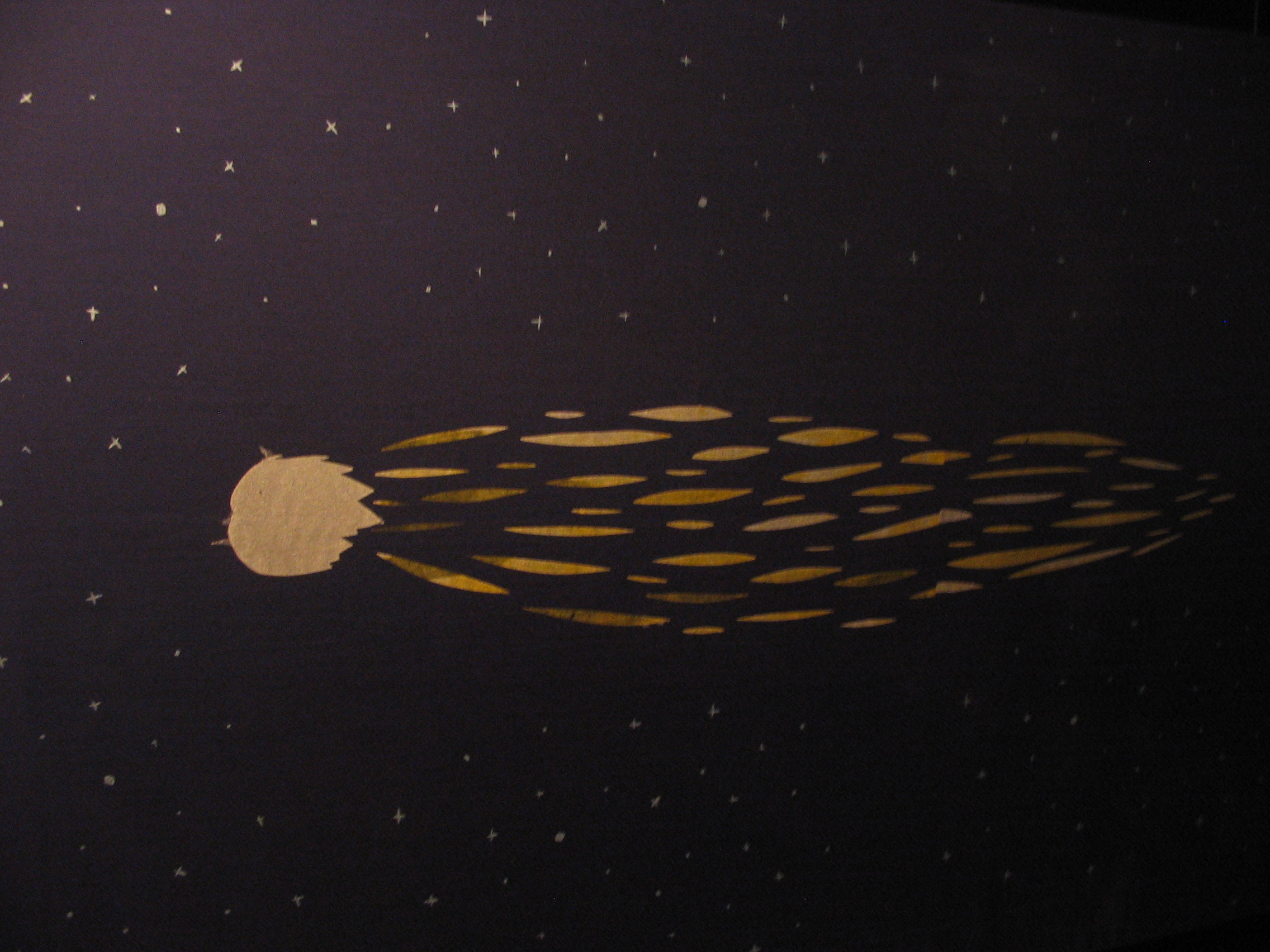Navigation 2
- right_en
- rightlower_en
Comets are celestial bodies rotating the Sun on very oval orbits. They consist of ice, snow and dust and their diametre is about twenty kilometres. Their orbit goes far beyond the orbits of the planets. The Sun’s radiation makes the comet’s matter evaporate near the Sun. Solar wind blows the thin gas away from the Sun creating a long tail. The picture introduces a student’s view of a comet. The artist is a member of an astronomical club NOVA (picture IH, Finland).

Aim: To get to know the essence and orbits of the comets. To prepare and test a mini-size model illustrating an orbit of a comet.
Explorations: Use discussion to recall the names of the parts in the solar system and after that discuss the comets. Let the students tell their impressions of them and their observations of them if they have any.
It is possible to observe comets because their tail reflects sunlight. Some comets have been observed even with a naked eye. Let’s reflect the meaning of ‘pyrstötähti’ (a celestial object with a tail), the Finnish name for a comet. Then discuss the orbits of the comets by comparing them with the orbits of the planets.
1) Working in teams, make a list of the most famous comets known by a special name. Add on the list all basic information that is available on these comets, such as rotation time, size of the comet core, length of the tail and shape of the orbit. Fix the list on the wall of the classroom.
2) Draw a sketch of a comet’s constructional features and write the names of the parts in the picture. Discuss with the students the substance of a comet core and the shape of the tail.
3) Sketch together or in teams the orbit of a comet through the solar system near to the Sun, around it and back beyond the orbits of the planets. Draw the comet in various phases of the orbit, especially near the Sun. Discuss with the students the behaviour of the tail. Seen from the Sun the tail of the comet is always behind the comet, i.e. the direction of the tail changes when the comet revolves the Sun. The solar wind blows the thin gas evaporated from the core to a long tail behind the comet core.
4) Prepare a mini-size model of a comet. The core of the comet can be made of paper mass or it can be a ready-made craft ball. Since the core consists of ice, stones and dust, a natural colour for that is light grey. For instance, cotton wool stretched thin may indicate a tail. Also a bunch of thin paper strips or pieces of woollen yarn – some longer, some shorter - can be used for this purpose. Hang the core of the comet in a yarn or fix a stick into it. The solar wind can be produced by using, for example, a hair dryer. Direct the blowing of the dryer to a table or a panel. That is how “the wind” spreads evenly in all directions. Take the comet on its imaginary orbit round the Sun. Draw the results in the picture in the previous task. Discuss how illustrative the model is and ponder suggestions for improving the model further.
5) * Use literature to explore the areas where comets are born, i.e. far beyond the orbits of the planets.
6) * Use source material for searching the latest information on comet probes. Many probes have been sent near some comets. They have collected information on the shape and substance of a comet core.
Methods: Use of various source materials for getting to know the motions and essential characteristics of a comet. Preparation of a mini-size model to visualize the function of a comet. Drawing illustrative pictures.
Materials: Balls, paper mass, cotton wool, hair dryer, woollen yarn.
Pondering: Discuss the revolution cycle of a comet. It is very interesting especially in a case when the comet only goes once near the Sun. What is the orbit like in that case? In addition to that, it is worthwhile to ponder the future of a comet after many revolution cycles.
Evaluation of the results: Compare the pictures the teams have made of the orbit of a comet and the effects of the
solar wind. Discuss various models and their functionality. Try to find and test suggestions for improving the models.
Hints: In addition to using a hair dryer, a plastic bulb with holes everywhere in it may be used. The main part of the holes should be concentrated on the level of the orbit plane.
Keywords: Comet, “pyrstötähti”, core of a comet, comet tail, Kuiper belt, solar wind, radiation pressure, elliptic orbit.
Previous page: Northern Lights
Seuraava sivu: Model of the Solar System

